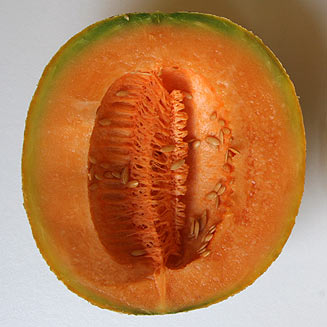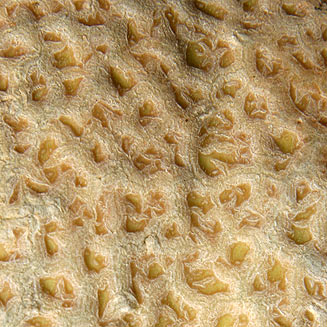|
Cucumis melo (Muskmelon, including wintermelon
and spanspek)
Life
> eukaryotes >
Archaeoplastida >
Chloroplastida
>
Charophyta > Streptophytina > Plantae (land plants)
> Tracheophyta (vascular plants) > Euphyllophyta > Lignophyta (woody plants)
> Spermatophyta (seed plants) > Angiospermae (flowering plants)
> Eudicotyledons > Core Eudicots > Rosids > Eurosid I
> Order: Cucurbitales > Family: Cucurbitaceae > Genus:
Cucumis
 |
 |
|
Cucumis melo at parkhome offices, Chitengo
Camp, Gorongosa National Park, Mozambique. [photos Bart Wursten ©,
Flora of
Mozambique] |
 |
 |
|
Canteloupe melon, a variety of Cucumis melo,
called Spanspek in South Africa. [photo
H. Robertson, Iziko ©] |
 |
 |
| Close-up of the rind of a canteloupe
melon. [photo
H. Robertson, Iziko ©] |
Winter melon, also called honeydew melon, another
variety of Cucumis melo. [photo
H. Robertson, Iziko ©] |
The wild Muskmelon has an indigenous distribution over the
desert and savanna regions of Africa, Arabia, southwestern Asia and Australia,
including in southern Africa, and was domesticated in Africa and
southwestern Asia more than 4000 years ago. It now comes in a range of forms
including those with netted rinds (e.g. spanspek / cantaloup) and those with
smooth rinds (e.g. wintermelon). Melons are usually eaten fresh as an hors
d'oeuvre at the beginning of the meal or as a dessert fruit at the end of
the meal.
Wild populations of Cucumis melo occur in desert and savanna regions
of Africa, Arabia, southwestern Asia and Australia. Within southern
Africa, it occurs in the South African provinces of Limpopo, Gauteng and
Mpumalanga. It is thought to have
been domesticated in Africa and southwestern Asia at least since 2000 BC. It was
introduced to the Americas by Columbus and later Spanish explorers and, as
with Watermelon, this species was extremely popular with North American Indians and
seeds were dispersed quickly from tribe to tribe. A wide range of cultivars have
been produced.
There are the unsweet varieties called chate Melons that are
consumed like cucumbers, but which are rarely grown today. The sweet varieties
include those with netted rinds (e.g. cantaloups / spanspek and persians)
and those with smooth rinds (e.g. casabas, honeydews and winter melons). Melons
are usually eaten fresh as an hors d'oeuvre at the beginning of the meal
or as a dessert fruit at the end of the meal.
Links
References
-
Sauer, J.D. 1993. Historical geography of
crop plants - a select roster. CRC Press, Boca Raton, Florida.
-
van Wyk, B.-E. 2005. Food Plants of the World -
Identification, Culinary Uses and Nutritional Value. Briza, Pretoria.
-
Zohary, D. & Hopf, M. 1993. Domestication
of plants in the old World - The origin and spread of cultivated plants in
West Asia, Europe, and the Nile Valley. Clarendon Press, Oxford.
Text by Hamish Robertson |
